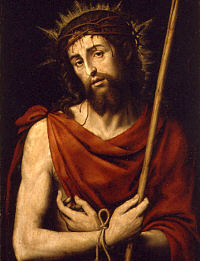Preparation for Death: Gone to Eternity
February 18, 2015 by Dan Burke
Preparation for Death
Editor’s Note: Today, Ash Wednesday, we begin our Lenten reflection series: “Preparation for Death”, written by St. Alphonsus M. Liguori and originally published in 1758. That means it contains some dated references. Nevertheless, its teaching is sound. This series is a very sobering set of reflections geared toward conversion of heart and offered for your Lenten contemplation. We warn you they are not for the faint of heart but will give you a lot to think about. Every consideration has three points to it. This year we will look only at point one of each consideration. The posts will be on site every day of Lent except Sundays and Holy Days, with the exception of Passion (Palm) Sunday when there will be a post from this series. The series will end on Wednesday of Holy Week. When you receive our daily notices, please scroll down the page to see all our offerings for that day. Thank you…and have a holy and blessed Lent.
Picture of a Man Who is but a Short Time Gone to Eternity
“Dust thou art, and into dust thou shalt return.
Genesis 3:19

Consider that thou art dust, and that thou shalt return to dust. A day will come when thou shalt die, and rot in a grave, where “worms shall be thy covering” (cf Isaiah 14:11). The same lot awaits all, the grandee and the peasant, the prince and the vassal. The moment the soul leaves the body, she shall go to her eternity, and the body shall return to dust. “Thou shalt send forth their breath, and they shall fail, and shall return to their dust” (cf Psalm 104:29). Imagine that thou beholdest a person who has just expired. Look at that body, still laid on the bed, the head fallen on the chest, the hair in disorder, and still bathed in the sweat of death, the eyes sunk, the cheeks hollow, the face the color of ashes, the lips and tongue like iron, the body cold and heavy. The beholders grow pale and tremble. How many, at the sight of a deceased relative or friend, have changed their lives and retired from the world!
Still greater horror shall be excited when the body begins to putrefy. Twenty-four hours have not elapsed since the death of that young man, and his body has already begun to exhale an offensive smell. The windows must be opened; a great quantity of incense must be used; and, to prevent the communication of disease to the entire family, he must be soon transferred to the church, and buried under the earth. If he has been one of the rich or nobles of the earth, his body shall send forth a more intolerable stench. “Gravius foetent,” says a certain author, “divitum corpora.”
Behold the end of that proud, of that lewd and voluptuous man. Before death, desired and sought after in conversations; now, become an object of horror and disgust to all who behold him. His relatives are in haste to remove him from the house; they hire men to shut him up in a coffin, to carry him to the churchyard, and throw him into a grave. During life, the fame of his wit, of his politeness, of the elegance of his manners, and of his facetiousness, flew in every direction; but after death, he is soon forgotten. ”Their memory hath perished with a noise” (cf Psalm 10:7).
On hearing the news of his death, some say, ”He was an honor to his family.” Others say, ”He has provided well for his children.” Some regret his death because he had done them some services during life: others rejoice at it because it is an advantage to them. But in a little time no one shall speak of him. In the beginning, his nearest relatives feel unwilling to hear his name, through fear of renewing their grief. In the visits of condolence, all are careful to make no allusion to the deceased; and should any one happen to speak of him, the relatives exclaim, “For God’s sake, do not mention his name.”
Consider that, as thou hast acted on the occasion of the death of friends and relatives, so others shall act on the occasion of thy death. The living take part in the scene. They occupy the possessions and offices of the deceased; but the dead are no longer remembered–their name is scarcely ever mentioned. In the beginning, their relatives will be afflicted for a short time; but they shall soon be consoled by the portion of the property of the deceased which will fall to them.
Thus in a short time thy death shall be rather a source of joy; and in the very room in which thou shalt have breathed forth thy soul, and in which thou shalt be judged by Jesus Christ, others will dance, and eat, and play, and laugh, as before. And where shall thy soul then be?
Affections and Prayers
O Jesus, my Redeemer, I thank thee for not having taken me out of life when I was thy enemy. For how many years have I deserved to be in hell! Had I died on such a day or such a night, what should be my lot for all eternity? Lord, I thank thee: I accept my death in satisfaction for my sins, and I accept it in the manner in which thou wilt be pleased to send it. But since thou hast borne with me till now, wait for me a little longer. ”Suffer me,— therefore, that I may lament my sorrow a little” (cf Job 10:20). Give me time to bewail, before thou dost judge me, the offenses I have offered to thee. I will no longer resist thy calls. Who knows but the words which I have just read may be the last call for me? I acknowledge that I am unworthy of mercy. Thou hast so often pardoned me, and I have ungratefully offended thee again. “A contrite and humble heart, O Lord, thou wilt not despise” (cf Psalm 51:19). Since, O Lord, thou knowest not how to despise a humbled and contrite heart, behold the penitent traitor who has recourse to thee. “Cast me not away from thy face” (cf Psalm 51:13). For thy mercy’s sake, cast me not away from thy face. Thou hast said, “Him that cometh to me I will not cast out” (cf John 6:37). It is true that I have outraged thee more than others, because I have been favored more than others with thy lights and graces. But the blood thou hast shed for me encourages me, and offers me pardon if I repent. My Sovereign Good, I am sorry with my whole soul for having insulted thee. Pardon me, and give me grace to love thee for the future. I have offended thee sufficiently. The remainder of my life I wish to spend, not in offending thee, but only in weeping unceasingly over the insults I have offered to thee, and in loving with my whole heart a God worthy of infinite love. O Mary, my hope, pray to Jesus for me.

 At the beginning of Lent, on Ash Wednesday, ashes are blessed during Mass, after the homily. The blessed ashes are then "imposed" on the faithful as a sign of conversion, penance, fasting and human mortality. The ashes are blessed at least during the first Mass of the day, but they may also be imposed during all the Masses of the day, after the homily, and even outside the time of Mass to meet the needs of the faithful. Priests or deacons normally impart this sacramental, but instituted acolytes, other extraordinary ministers or designated lay people may be delegated to impart ashes, if the bishop judges that this is necessary. The ashes are made from the palms used at the previous Passion Sunday ceremonies.
At the beginning of Lent, on Ash Wednesday, ashes are blessed during Mass, after the homily. The blessed ashes are then "imposed" on the faithful as a sign of conversion, penance, fasting and human mortality. The ashes are blessed at least during the first Mass of the day, but they may also be imposed during all the Masses of the day, after the homily, and even outside the time of Mass to meet the needs of the faithful. Priests or deacons normally impart this sacramental, but instituted acolytes, other extraordinary ministers or designated lay people may be delegated to impart ashes, if the bishop judges that this is necessary. The ashes are made from the palms used at the previous Passion Sunday ceremonies.